Golden ratio
Info from: Wikipedia, and Phi: That Golden Number by Mark Freitag, godennumber.netMost people are familiar with the number Pi, since it is one of the most ubiquitous irrational numbers known to man. But, there is another irrational number that has the same propensity for popping up and is not as well known as Pi. This wonderful number is Phi, and it has a tendency to turn up in a great number of places, a few of which will be discussed.
Some of the greatest mathematical minds of all ages, from Pythagoras and Euclid in ancient Greece, through the medieval Italian mathematician Leonardo of Pisa and the Renaissance astronomer Johannes Kepler, to present-day scientific figures such as Oxford physicist Roger Penrose, have spent endless hours over The Golden Ratio and its properties. But the fascination with the Golden Ratio is not confined just to mathematicians. Biologists, artists, musicians, historians, architects, psychologists, and even mystics have pondered and debated the basis of its ubiquity and appeal. In fact, it is probably fair to say that the Golden Ratio has inspired thinkers of all disciplines like no other number in the history of mathematics.
Ancient Greek mathematicians first studied what we now call the golden ratio because of its frequent appearance in geometry. The ratio is important in the geometry of regular pentagrams and pentagons. The Greeks usually attributed discovery of the ratio to Pythagoras or to the Pythagoreans, particularly Theodorus or Hippasus. The regular pentagram, which has a regular pentagon inscribed within it, was the Pythagoreans' symbol.
The golden ratio, expresses the relationship that the sum of two quantities is to the larger quantity as the larger is to the smaller.
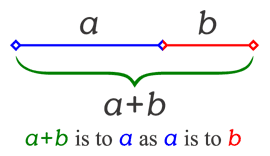
The golden ratio is the following algebraic irrational number with its numerical approximation:

The figure of a golden section on the right illustrates the defining geometric relationship. Expressed algebraically:

Other names frequently used for or closely related to the golden ratio are golden section, golden mean, golden number, and the Greek letter phi. Other terms encountered include extreme and mean ratio, medial section, divine proportion, divine section, golden proportion, golden cut, and mean of Phidias.
At least since the Renaissance, many artists and architects have proportioned their works to approximate the golden ratio-especially in the form of the golden rectangle, in which the ratio of the longer side to the shorter is the golden ratio-believing this proportion to be aesthetically pleasing. The golden ratio also makes surprising appearances in nature. Mathematicians have studied the golden ratio because of its unique and interesting properties.
Aesthetics
Beginning in the Renaissance, a body of literature on the aesthetics of the golden ratio has developed. As a result, architects, artists, book designers, and others have been encouraged to use the golden ratio in the dimensional relationships of their works.
The first and most influential of these was De Divina Proportione by Luca Pacioli, a three-volume work published in 1509. Pacioli, a Franciscan friar, was known mostly as a mathematician, but he was also trained and keenly interested in art. Da Vinci himself maintained that the human body has proportions that approximate the golden ratio.
Phi and the Golden Section in Architecture
Phi, the Golden Section, has been used by mankind for centuries in architecture Its use started as early as with the Egyptians in the design of the pyramids:
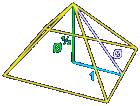

The Greeks knew it as the "dividing a line in the extreme and mean ratio" and used it extensively for beauty and balance in the design of the Parthenon and other architecture:
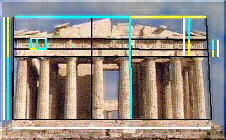
Renaissance artists from the time of Leonardo Da Vinci knew it as the Divine Proportion, and used it in the design of Notre Dame in Paris:
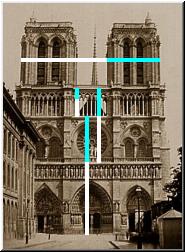
Its use continues in modern architecture, as illustrated in the United Nations building, and in the CN Tower in Toronto (which contains the golden ratio in its design. The ratio of observation deck at 342 meters to the total height of 553.33 is 0.618 or phi, the reciprocal of Phi):


The Human Face
The human face is based entirely on Phi
The first golden section (blue) from the front of the head defines the position of the ear opening. The successive golden sections define the neck (yellow), the back of the eye (green) and the front of the eye and back of the nose and mouth (magenta). The dimensions of the face from top to bottom also exhibit the Divine Proportion, in the positions of the eye brow (blue), nose (yellow) and mouth (green and magenta).
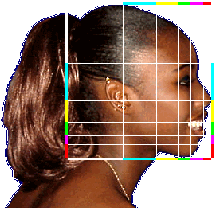
The front two incisor teeth form a golden rectangle, with a phi ratio in the heighth to the width. The ratio of the width of the first tooth to the second tooth from the center is also phi. The ratio of the width of the smile to the third tooth from the center is phi as well.

Phi in Marketing and Product Design
Phi is used in the design of many consumer products
Phi has been used to bring beauty, balance and harmony to some of the world's greatest art and architecture.
It is also used to add style and appeal in the marketing and design of everyday consumer products.